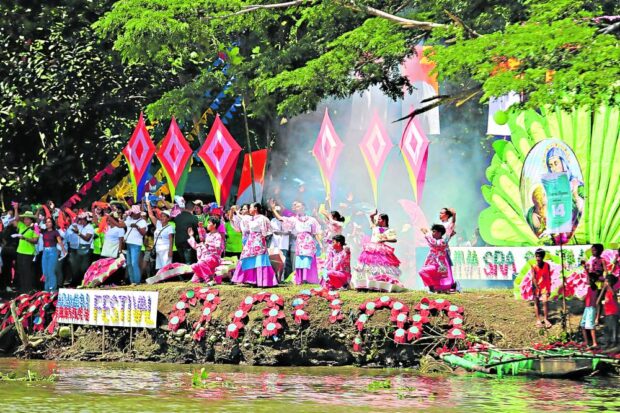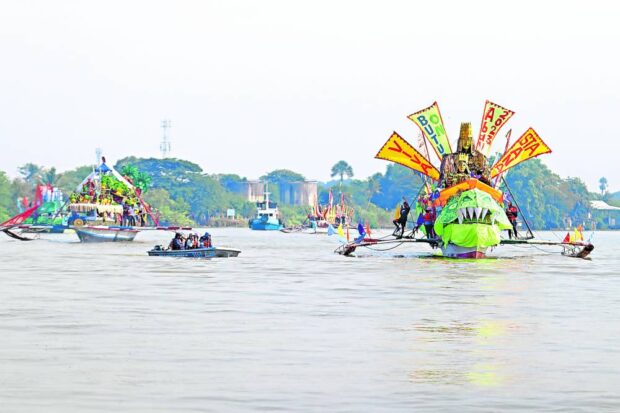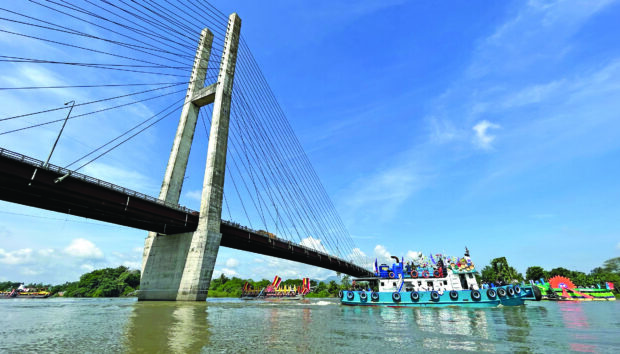Butuan rediscovers ‘abayan,’ a centuries-old ritual

HISTORIC RITUAL | Residents of Butuan City’s Barangay Obrero (above) chant and dance as the fluvial procession passes by their riverside community during the recent Abayan Festival. The col- orful floats (photos below) show the significance that locals attach to the historic ritual performed to protect villagers from crocodile attacks and flooding. (Photo by ERWIN M. MASCARIÑAS / Inquirer Mindanao)
BUTUAN CITY, Agusan del Norte, Philippines — On July 30, thousands of people gathered along the banks of Agusan River in Barangay San Ignacio here to hear Holy Mass after which several hundreds boarded boats for a fluvial procession in honor of Santa Ana, the river’s patron.
As the procession passed by riverside communities, people waved and cheered. Contingents of well-wishers from 23 of the city’s 86 barangays gathered on the riverbanks to greet the procession, performing a host of songs and dances.
Called “abayan,” this ritual dates back to the late 17th century when locals implore divine intervention to help them ward off crocodiles that prowl for prey among humans who cross the Agusan River for trade, fishing, and other daily activities.
Abayan comes from the Visayan word “abay” meaning companion, guide, and guardian. Hence, the ritual seeks God’s protection and guidance that the people who frequent the river be safe from attack by the reptiles, as well as from the regular floods that sweep across the Agusan plains.
Local historian Greg Hontiveros has traced the tradition to the time of the Spanish occupation when the Catholic faith, and along with it the worship of saints, was introduced to the local population.
“An old Spanish bell can be found in the church at Barangay San Vicente, bearing the year 1796 and the name Santa Ana. These suggest that the saint had been part of the early Butuan tradition, acting as a secondary patron alongside St.Joseph,” Hontiveros added.
Crocodile attacks

(Photo by ERWIN M. MASCARIÑAS / Inquirer Mindanao)
He also cited historical records indicating the existence of three bells inscribed with the names Santa Ana, San Jose, and San Francisco de Sales, confirming their reverence by the locals.
“The practice during the Spanish colonial times was to seek protection (through the intercession of Santa Ana) against crocodile attacks and the regular flooding that devastated the land. In those days, with no roads available, the river was the primary mode of transportation, a hub for trade and commerce, as traveling through the dense forest was arduous and time-consuming,” Hontiveros said.
The third longest in the country, the Agusan River emanates from the mountains of Pantukan town in Davao de Oro province, snaking through Agusan del Sur and draining into the Agusan marsh.
From the over 19,000-hectare marsh, its waters further flow through Agusan del Norte and empty into Butuan Bay, passing by this city, in all journeying some 349 kilometers, nourishing the agriculture-rich flood plains along its path.
Up until the 1980s, the river was the principal means of interlocal mobility in a big part of the Caraga region. What is now the compound of the Philippine Ports Authority in Barangay San Ignacio used to be a bustling harbor that catered to interisland passenger shipping as well as large cargo boats that load logs for export.
From San Ignacio, passenger boats ply a route to the interior town of Magallanes, and also to Cebu City in Central Visayas.
By the early 1980s, navigation along the Agusan River became difficult as it got shallower with silt deposits coming from the upstream which saw decades-long sustained logging activities. This led bigger ships to start dropping anchor in nearby Nasipit town.
In 2021, after undergoing repair and rehabilitation, the old Masao port in Barangay Lumbocan that used to serve smaller cargo boats, opened for roll-on, roll-off vessels.
In modern times, Butuan has been staging the Abayan Festival in observance of its founding anniversary as a city.
Environmental threats
After a three-year hiatus due to the COVID-19 pandemic, the festival was staged on July 30 as a reminder of the importance of the Agusan River and its historical influence in shaping the city’s development.
Navigating and crossing the river now may no longer pose the same threats to human life as before, but the same saltwater crocodile of old still lurks in the Agusan marsh.
But the threats to the local population due to the environmental decline of the river have alarmed Butuan’s leaders.
Mayor Ronnie Vicente Lagnada stressed the need to protect the river and its fragile ecosystem and stand against environmental threats caused by illegal mining and logging in the upstream communities.
Add to this the worsening problem of solid waste management amid the growing population of the city.
Just like in the olden times, the city’s riverside communities are increasingly bedeviled by flash floods, with the frequency and intensity of rains spawning these getting extreme.
Lagnada revealed that ongoing development projects along the Agusan River would protect people in flood-prone riverside communities and at the same time make the waterway an attractive destination for tourists.
Journey
Fr. Chito Butardo, the parish priest of St. Joseph Cathedral, emphasized the significance of the festivity in honor of Santa Ana, the patron saint of the rivers in Agusan province.
“This is simply a representation of our journey, our sail as people. It is a community that tries and endeavors to ascend, it is a city that tries to climb, it is a city that tries to sail with the current and sometimes against the current,” Butardo said.
He also urged the community to remain steadfast, even when faced with seemingly insurmountable difficulties. He drew parallels from the life of St. Anne and her husband, Joaquin, exemplifying their unwavering faith despite their struggle to conceive.
“As we witness the abayan, let us look at the river again, and let’s see the promise it gives us. It continues to flow whether we like it or not, we can decide to get off the river but that river will continue to give us what we deserve,” he added.
